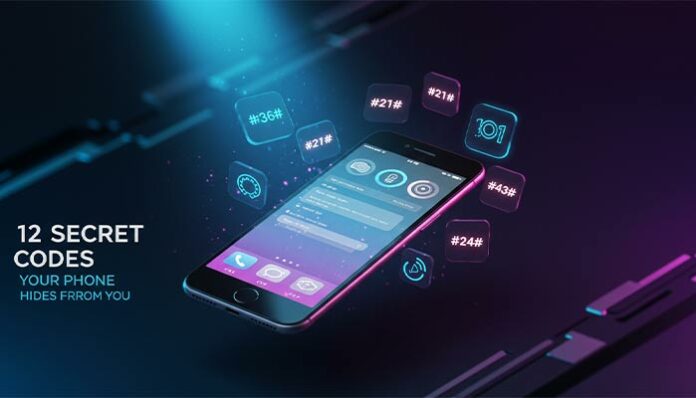Our phone has a bunch of hidden settings and features, including secret codes, that most people don’t notice, just waiting for you to find them.
Basically, it’s like leaving hidden shortcuts in a system, and just like in the movie, hackers use them to slip past security without being noticed.
Programmers have been sneaking in hidden features, called Easter eggs, in software since the beginning of computers. These little surprises can only be discovered by entering a secret code.
USSD first appeared on older GSM phones, but it still works well on today’s 4G and 5G devices. It lets you access hidden features and settings that you won’t find in regular menus. Think of it like opening a secret door to explore parts of your phone you normally don’t see. You might discover cool tools and options that make your phone feel brand new. By trying out these secret codes, you can customize your phone in fun and unexpected ways.
To use these codes, you just enter them into your phone’s dialer, like you would when making a call. They usually start and end with * or #, with some numbers in the middle. This setup makes it hard to type them by mistake while you’re texting or browsing—you have to know the code to unlock these hidden features.
Just a quick heads-up: some secret codes come with risks. Certain ones—especially those that include words like “wipe”—can erase your data or even reset your phone entirely. Exploring hidden features can be fun, but it’s smart to stay cautious. One wrong code could clear everything and leave you dealing with a lot of stress. To protect your phone, steer clear of any codes that seem suspicious or have the potential to cause damage.
Things get more confusing when phone companies are involved. Most of them don’t want regular users playing with these secret codes. That’s why they sometimes block the codes or change how they work. A code that worked yesterday might not do anything today—or just stop working completely. This helps stop people from changing something important by mistake. So even if you find a cool code online, there’s no guarantee it will still work on your phone.
Even though a lot of secret codes didn’t work, a few of them actually did something. We’ve listed the ones that showed results at least once. Using these feels like a small adventure, helping you find hidden features on your phone that most people don’t know about. It’s a fun way to learn more about what your phone can do. Just be a little careful while trying them out—and enjoy exploring!
See Secret iPhone Network Details Using (*3001#12345#*)
Most of the secret codes we tried didn’t do anything, but a few actually worked. Even the small results felt exciting because we never knew what to expect. Those little surprises made the whole experience fun and worth it. It’s like discovering a hidden button on something you use every day—suddenly, you realize your phone can do a lot more than you thought.
Check Your IMEI Number Quickly with This Easy Code (*#06#)
If you have an iPhone, you can find your IMEI number by going to Settings, then General, and tapping on About. Just scroll down a little, and you’ll see it there. But if you want the fastest way—on almost any phone—just dial *#06# on your screen. Your IMEI number will quickly show up, just like that. It’s a simple and helpful trick that many phone experts use because it works on nearly all phones.
Use (*#67# and *#21#) to See If Calls Are Forwarded
It’s very helpful if you want to make sure your calls are going to the right number when you can’t answer.
Dial *#67# to see which number your calls go to when you can’t answer. In most cases, this is your carrier’s voicemail service—like AT&T’s Voicemail Call Center. By default, your phone forwards calls there when you’re busy or unreachable. But you’re not stuck with that option. You can choose to forward calls to any number you prefer, whether it’s your home phone, your work line, or a different voicemail service that suits you better.
Set Up Call Waiting with (43) and More Codes
When you’re on a call, call waiting lets you know if someone else is trying to reach you. It’s a useful feature that helps you avoid missing important calls without having to hang up or stop your conversation.
While experimenting, I discovered that entering *#43# on AT&T turned off several features like voice call waiting, data call waiting, fax call waiting, SMS call waiting, and something called sync data circuit call waiting (not quite sure what that one does!). To turn voice call waiting back on, I dialed 43# and checked in the Settings > Phone > Call Waiting section of my iPhone to make sure it was reactivated. This code should work for T-Mobile users too.
If you’re using Verizon, dialing *43 will turn off Call Forwarding, but it won’t affect Call Waiting. To restore Call Forwarding, simply dial *42. If you want to temporarily disable Call Waiting for a particular call, just dial *70 before the 10-digit number.
There Are (646) Minutes Remaining
Here’s a fun fact: the numbers 646 on your phone keypad spell out “MIN.” If you’re using AT&T on an iPhone, just dial *646# and your phone will send you a text showing how many minutes you have left. Android users get the same info by text—it just won’t pop up on the screen right away. AT&T uses this secret code to help you check your remaining or rollover minutes. Prefer Spanish? Dial *876# instead. If you’re on Verizon, use #646, and for T-Mobile, dial #646#.
Pending Bill Amount: (225)
Instead of displaying a hidden screen, this code sends a text message with your current billing balance. The number 225 stands for “BAL” (balance). For AT&T, you can dial *225#, while Verizon users should use #225. T-Mobile customers can check their balance by dialing #225#.
Your Account Billing Period: (3282)
When you dial this code, your phone sends a request and quickly gets a text message with all the key details about your data usage. The message shows when your billing cycle started, how much data you’ve used so far, and if you have multiple lines, it includes usage info for each one. It also alerts you if you’ve gone over your data limit. On your keypad, the number 3282 spells out “DATA.”
Every carrier has its own way of checking data usage: AT&T users dial *3282#, Verizon users should call #3282, and T-Mobile customers can check with #932#.
Keep Your Number Hidden with (#31#)
When I tried this code, a message appeared telling me that my Caller ID (or Calling Number Display, CND) was disabled. To enable it again, you can dial *31#, or you can go into your iPhone’s Settings > Phone to turn it back on.
If you need to block your Caller ID for a single call, you can use this code. Just dial #31# (or *67, which is more commonly used) before the phone number you want to call. For example, it will look like #31#1234567890. This is especially useful for landlines, where turning off Caller ID often requires calling customer support.
To make your number visible just once,
simply dial *82 before entering the phone number — it will show up for that call.
Dial (*5005*25371#) to Get Your Alert Details
By entering this code, you can verify if your phone is set up to get test alerts from emergency or government services. It won’t send a real alert, but it will confirm if the service is enabled on your device. If you’d prefer to turn it off, simply dial 500525370# and press the call button to disable it.
See Your Account Balance with (*777#) (Prepaid) or (*225#) (Contract)
To check your remaining balance on a prepaid phone, dial *777# and press the call button. The system will send you a text message showing your available balance. If you’re on a postpaid or different type of plan, the system will let you know that this code doesn’t apply to your account. Postpaid users can dial *225# to check their current bill.
Check Your Android Stats with (*#*#4636#*#*)
When you enter this code, it opens a hidden settings screen packed with details like your phone’s 5G or LTE status, Wi-Fi information, NFC settings, and usage stats. It might feel a bit technical, but if you take a look around, you could discover something useful or interesting.
Clear All Data and Reset Your Android with (*2767*3855#)
Although we didn’t try this code ourselves, it’s reported to perform a full reset on Android devices. It clears all data and reinstalls the phone’s original operating system.

